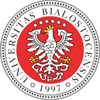Proszę używać tego identyfikatora do cytowań lub wstaw link do tej pozycji:
http://hdl.handle.net/11320/17155| Tytuł: | Mickiewicz - mit - historia. Studia |
| Inne tytuły: | Mickiewicz – mythe – histoire. Études Mickiewicz - myth - history. Studies |
| Autorzy: | Ławski, Jarosław |
| Data wydania: | 2010 |
| Data dodania: | 2-wrz-2024 |
| Wydawca: | Wydawnictwo Uniwersyteckie Trans Humana |
| Abstrakt: | Presented book is entirely devoted to the works of Adam Mickiewicz (1798-1855), the greatest poet of Polish Romanticism. Included studies concern issues signalled in the title: firstly, the symbolic associations of the mythic imagination and the history of the nineteenth century, and secondly, the relationship between sacrum and the ideas on the historical order. The key concepts of this argument are: a myth, symbol, history, Messianism, Providence, Book, Lithuania, the idea, religion and creed. The texts are grouped into three blocks: I: Word, narration, revelation (Słowo, narracja, objawienie); II: University, word, historiography (Uniwersytet, słowo, dziejopisarstwo); III: Interpretation, topos, word (Interpretacja, topos, słowo). The book is preceded by the introduction entitled The citizen of the Commonwealth of all nations (Obywatel Rzeczypospolitej wszystkich narodów), showing the dilemmas of the nineteenth-century Pole and European, who in order to clarify his fortunes uses messianic religious thought and simultaneously enjoys the benefits of the French Enlightenment. The first chapter, From the Historiography to the philosophy of history. Reflection on methods for understanding the past (Od Historiografii do historiozofii. Refleksja o metodach poznania przeszłości) (1820-1840), shows the enthusiasm with which Mickiewicz undertook to reflect on history and how he tried to write his historiographical works. Most of his projects in this area, however, ended in failure. This also applies to the monumental project The Polish History (Historia polska). The second chapter, Mickiewicz's understanding of myth/mythodology in writings from 1818-1838 (Mickiewiczowskie rozumienie mitu/mitologii w pismach z lat 1818-1838), reveals distrust of the young and mature poet to the category of myth, which is replaced in his deliberations by categories such as fairy tale, fable or legend. Only in mature work, a myth is defined as a story that transfers the Revelation of God. Then it became appreciated in Mickiewicz's lectures at the Collège de France as a tool to know the secrets of God and the world, history and people. The third chapter, Empty sky above Switez? Romanticism and egalitarian art (Puste niebo nad Świtezią? Romantyzm i sztuka egalitarna), shows the impact of this trend on the development of popular and mass art (theatre, novels in instalments and even contemporary film series). The fourth chapter, Poetics of the Book and Slavic myth - about Parisian lectures (Poetyka Księgi i mit Słowiańszczyzny - o prelekcjach paryskich), is the analysis of poetic and mythic structure of lectures, which were proclaimed by Mickiewicz at the Collège de France. The work shows a further transformation of Mickiewicz's thoughts: from fascination with the Messianism to acceptation of theosophical thought of Andrzej Towiański that contains both elements of Christianity or mysticism, as well as metempsychosis. The fifth chapter, Discoverer of „Slavic continent". The inaugural lecture at the Collège de France (Odkrywca „słowiańskiego kontynentu". O wykładzie inauguracyjnym w Collège de France) is a detailed interpretation of the first public appearance of Adam Mickiewicz as a professor of Slavic literatures. The professor appears as a man who understood the importance of his mission, but also felt the pressure of Polish immigrants, students from Slavic countries, the French government and Russian agents. The sixth chapter, Slavic sacrum: from the „Polish History" to Parisian lectures (Sacrum słowiańskie: od „Historii polskiej" do prelekcji paryskich), shows Mickiewicz's concept of religious sources, images of sanctity the Slavs had before adopting the Christianity. The writer associates these ideas with Proto-Indo-Europeans' religion and their journey from India to Europe. The seventh chapter, „Eidos" of imagination. The hero „Dziady" between epic and tragic experience of world („Eidos" wyobraźni. Bohater „Dziadów" między epopeicznym a tragicznym doświadczeniem świata), reveals two kinds of contradictions and tensions, which the world presented in the most important romantic drama in Poland contains. This is the first tension between surfaced and imperfect, touched by evil, dimension of nature and history, culture and art and their ideal dimensions associated with the perfect and eternal idea. The second tension is a contradiction between the tragic reality of the nineteenth century and the state of innocence, an idyll, epic that the modern individual lost together with their childhood and which wants to recover. The eighth chapter, Mickiewicz's Vilnus: the city, symbol and myth (Mickiewiczowskie Wilno: miasto, symbol, mit), is an attempt to describe the capital of the Great Duchy of Lithuania as a city that had left mark on the whole imagination and creativity that Mickiewicz had. The author analyzes both the debut of a poet, a poem City Winter (Zima miejska), as well as late symbolic and metaphysical presentation of Vilnius's space, where the poet always wanted to reach through Constantinople. The ninth chapter, The life of decent protestant. Mikolaj Rej in Adam Mickiewicz's writings (Żywot protestanta poczciwego. Mikołaj Rej w lekturze Adama Mickiewicza), discloses a method of interpretation of the writings of the most important writers of the Old Polish age. Mickiewicz, who was both an apologist and critic of Catholicism (for example, Jesuits), highly praised the writings and patriotic attitude of creativity of Calvinist Rej . He did this despite the fact that he was a fierce critic of protestantism and whole Reformation. The final chapter Mickiewicz, the community, history (Mickiewicz, wspólnota, historia) raises the following questions: who was the patron of Polish culture in nineteenth century? How should we re ad Mickiewicz today: postmodernistically, from the perspective of the a historian of literature, or existentially? The essential postulate of the research is: Mickiewicz as a patron of the whole nineteenth century should be read again from scratch. We must look at his text and reject the contemporary ideological or even philosophical suggestions and ways of interpretations. AlI the work closes extensive and selected bibliography included in the slogan: History, historiology, context (Dzieje, historiologia, kontekst). The book is comparative. The basis of an analysis forms rarely interpreted works such as lectures in Lausanne and Paris, Mickiewicz's historical writings and his letters. The author points out that one of the main Mickiewicz's objectives was the creation of the great synthesis of the history, thoughts, religion and art. He did not create it as a historian, but this synthesis was generated by the lectures delivered at Collège de France. [Translated by Anita Janicka] |
| Sponsorzy: | Edycja sfinansowana ze środków: Rektora Uniwersytetu w Białymstoku oraz Dziekana Wydziału Filologicznego |
| Opis: | Zdigitalizowano i udostępniono w ramach projektu pn. Rozbudowa otwartych zasobów naukowych Repozytorium Uniwersytetu w Białymstoku – kontynuacja, dofinansowanego z programu „Społeczna odpowiedzialność nauki” Ministra Edukacji i Nauki na podstawie umowy BIBL/SP/0040/2023/01. |
| URI: | http://hdl.handle.net/11320/17155 |
| ISBN: | 978-83-61209-45-4 |
| Typ Dokumentu: | Book |
| Właściciel praw: | © Copyright by Jarosław Ławski, Białystok 2010 © Copyright by Wydawnictwo Uniwersyteckie Trans Humana, Białystok 2010 |
| Występuje w kolekcji(ach): | Książki / Rozdziały (STH) Książki/Rozdziały (WFil) |
Pliki w tej pozycji:
| Plik | Opis | Rozmiar | Format | |
|---|---|---|---|---|
| J_Lawski_Mickiewicz_mit_historia_studia.pdf | 16,8 MB | Adobe PDF | Otwórz |
Pozycja jest chroniona prawem autorskim (Copyright © Wszelkie prawa zastrzeżone)

